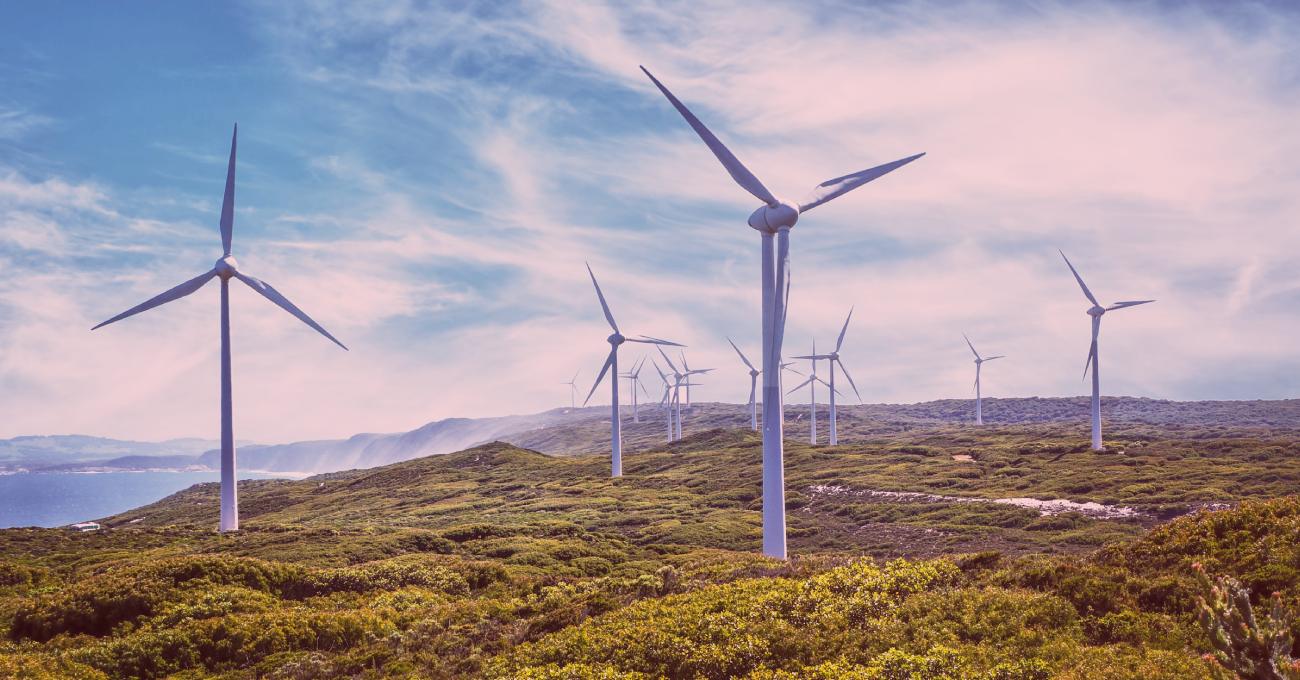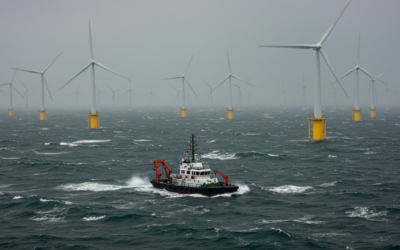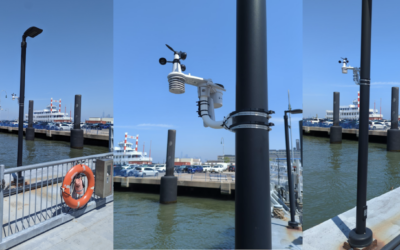Wind Energy Forecasting Techniques With IoT & Machine Learning
According to recent research by IEA, offshore wind will become a macro contributing source of electricity in the European Union by 2040 and is already contributing roughly 8.4% of total energy in the USA. Focusing on carbon-free renewable energy like wind energy can help stabilize our climate. Wind energy forecasting techniques will become increasingly more critical as more resources are put into scaling up wind energy production.
Over the last decade, wind farms have become an abundant source of renewable electricity. This is because the cost of turbines has declined significantly, thus increasing adoption. However, the inherently variable nature of wind energy can make it an unpredictable source of energy.
Transition to renewable energy
Climate change has become a huge concern worldwide. And this has pushed governments and corporations towards more renewable energy sources, like wind power and solar. More people are starting to rely on these renewable energy sources. By 2025, the renewable energy market is anticipated to reach about 2.15 trillion US dollars. As the demand steadily increases, energy providers and manufacturers are facing new challenges as they are looking for better ways to manage the rapidly expanding infrastructure.
Challenges of wind forecasting
You may have noticed that meteorologists can achieve an acceptable level of accuracy for temperature prediction for normal consumers. However, this is not the case for wind and especially wind predictions for commercial use. Wind patterns are incredibly complex for a multitude of reasons and it does not help that climate change may be shifting many ancient wind patterns like the Gulf Stream right in front of our eyes.
Unpredictability and variability of wind energy
A dependable source of energy needs to have high predictability and low variability. Although moderate variation can be tolerated, low predictability fundamentally challenges viability. This is why accurate weather prediction is crucial to achieving useful and reliable wind power forecasts.
Wind forecasting is easier over the open ocean with current forecasting techniques. There are no buildings, trees, or mountains to create friction or redirect or funnel the wind. However, on hitting the land, the wind is affected by 3D topography. This can decelerate or accelerate or even block or redirect the wind locally. For the safe and efficient operation of windmills and distribution of electric energy generated from wind power, it’s vital to accurately forecast and predict wind speed.
Leveraging the internet of things (IoT) and machine learning (ML)
The accuracy of weather predictions improves with a shorter forecast horizon. Also, combining different predictions from models using various numerical techniques is beneficial. While we cannot control the weather, the wind energy industry can make the most of the advancement of AI (artificial intelligence) technologies, IoT (Internet of Things), and machine learning to improve the predictability, forecasting, and efficiency of energy resources. A key scenario is maintenance scheduling in periods of low wind energy.
Luckily, we are going through rapid digitalization. And big players like Industrial IoT, AI, and intelligent automation can provide newer and better ways to conduct our daily businesses. Machine learning has been well integrated into several aspects of everyday life, such as smart devices and social media. Now it is possible to use machine learning to help the environment by predicting wind patterns among many other use cases.
Data Logging and IoT Devices for wind forecasting
The use of data-logging equipment for recording and monitoring events is not new. Did you know that the earliest data-logging process entailed manually recorded weather sensor readings that professionals plotted on graph paper? Today, almost all data logging is electronic. Keep in mind that predicting the weather has never been simple. This is true even as technology advanced considerably, and more methods have become accessible for anticipating meteorological trends. However, mother nature has remained somewhat inscrutable.
The good news is that with the IoT, these predictions have become simpler, more reliable, and accurate. This is not only for local news stations but for other parties, such as farmers, who rely on weather data for conducting their operations. Innovative electronic developments have considerably advanced data-logging techniques and methods. Now, products that target the growing IoT movement are finding their way into the latest data-logging equipment.
Types of Data Loggers and Sensors
Data loggers and sensors are available in multiple forms. However, they generally break down into four main types.
•Standalone
These are often small and battery-powered devices that can use a single sensor or more than one sensor. These sensors are signal conditioned, sampled, and then multiplexed. They are sent to an ADC (analog-to-digital) converter and stored in flash memory.
•PC-based
In PC-based systems, the sensors timely feed a data-logging module. The module is connected directly to the PC. A PC system is more desirable as the best software offers real-time display. You can benefit from timely visualization as the sensors update. This offers instantaneous data analysis and massive data storage capability.
•Web-based
Web-based systems are either PC-controlled or standalone. These systems are connected to the Internet through a wired or wireless network.
•Wireless
Finally, a wireless data logger utilizes wireless technology for transmitting data. The data is sent to a site where it is collected and used as the application deems fit. A huge range of wireless options is now available. Some include Wi-Fi, Bluetooth, ISM band, ZigBee, NFC, and cellular (M2M).
•IoT weather and wind sensors
We can bolster the capabilities of weather and wind forecasting technologies with IoT-enabled devices. Wind sensors connect in order to share crucial data that we can use to adjust metrics and make the information-gathering process more accurate. The wind is measured with an anemometer. The latest anemometers offer amazing capabilities and are designed to be used in the hardest environmental and weather conditions. Many wind sensors are compact and have applications in urban meteorology, agriculture, and smart city projects. These sensors are connected to various destinations that may need insight into meteorological trends. These may include airliners, news stations, and logistics companies.
With the latest IoT devices and machine learning, we can use accurate short-term wind power forecasting to identify wind power fluctuations ahead of time to mitigate the effect of wind intermittency on the power system with high wind penetration. Typically, wind power and wind speed forecasting around a wind farm require you to calculate the next moment of the definite state. This is often achieved on the basis of the state of the atmosphere, which encompasses nearby temperature, atmospheric pressure, roughness, and obstacles. We can theoretically use a deep neural network to deal with arbitrary nonlinear transformation via proper structural design. This can include adding noise to outputs and using evolutionary learning to optimize hidden layer weights.
Leveraging the latest technology, we can optimize the objective function and save information that can help enhance the output accuracy while filtering out all irrelevant or less affected information for wind forecasting.
Challenges in reducing forecasting inaccuracy in wind turbine operation and how IoT and AI can help
The managed service provider for windmill forms may face many performance and sustainability issues. Some examples are an incorrect power output forecast, decreasing energy revenue, and non-scalable process management (maintenance and resource scheduling). As a result, the implementation of predictive and preventive maintenance in the life cycle of wind turbines is necessary to achieve higher efficiencies of scale. This helps reduce the risk of sudden component failure. Did you know that organizations across the whole ecosystem are now focusing on enabling and facilitating their business units with the latest technologies?
Forecasts of some base variables, such as wind speed and global horizontal irradiance, allow for a comprehensive view of many time horizons, from just minutes and hours ahead to a day-ahead. With the availability of increasingly larger data sets, wind forecasts and predictions can go beyond the weather. It is possible to train algorithms to predict even more remarkable outcomes. More accurate and reliable forecasting of wind energy at shorter timescales is essential for energy traders and generators. This is because it allows them to more accurately forecast their output and bid in the wholesale market.
Smart grids improve wind energy forecasting
Smart grids use many operation and control systems, intelligent circuit breakers and boards, and advanced metering systems. Their operations are considerably more efficient and can be easily evaluated. This is due to the availability of needed information. And in such a system, wind energy forecasting and scheduling can truly thrive. We can introduce advanced forecasting models and use them to plan how the plants would run. The ease and simplicity in integration are because the smart grid already has various smart IoT devices. These devices help with thermal sensing, phasor management networks, and smart meters.
Automation with IoT and AI
Efficiency is one of the major hurdles in harnessing renewable energy, such as wind power. This is particularly true for methods that rely on variable resources, such as wind and solar energy. However, a smart IoT solution facilitates the implementation of automated controls. This helps improve the efficiency of electricity production. Note that an IoT device can help identify the most favorable conditions for energy production. You can adjust the equipment accordingly to generate maximum output.
A great example of automation using IoT devices is their use in monitoring the efficient working of wind turbines. It is possible to alter the direction of the wind turbine to gain maximum efficiency by analyzing and assessing the data produced by IoT sensors.
Why wind energy and the IoT and AI Make Sense
Wind farms are often located in isolated areas. As a result, it is expensive and infeasible to deploy a permanent and costly maintenance department at these locations. However, if there’s an error, travelling to the site can take many hours. This is where IoT and AI could do wonders, reducing logistic and maintenance costs. For example, the engineers or technicians can gather relevant data remotely via IoT and maintain essential components, such as electrical generator, hydraulics system, electronic controller, and cooling unit.
How Benchmark Labs can help
If you are looking to reduce your operating costs and get more insights on when and how weather conditions will affect your operations, Benchmark Labs can help you through its proprietary machine-learning software in order to provide precise and reliable asset-specific weather forecasting, specifically wind forecasting.
As a thought leader in IoT-based weather forecasting, Benchmark Labs is changing how companies can make decisions based on real-time weather, using high-resolution weather data and AI-based predictive models.
Recent Posts
Revolutionizing Offshore Wind Farm Installation and O&M with Benchmark Labs
Offshore wind farms demand precise weather information to perform installation, and operations and maintenance activities, as they are vulnerable to atmospheric and ocean conditions. Therefore, accurate weather forecasts are crucial for safe, complex operations. Why...
Benchmark Labs and Seeed Studio’s Collaboration: A New Era of Offshore Vessel Safety
At Benchmark Labs, we're dedicated to pushing the boundaries of weather forecasting through the power of AI and machine learning. Our mission is to provide hyperlocal, point-specific forecasts that empower industries to make informed decisions and operate safely, no...
Benchmark Labs Launches In-Situ Evapotranspiration Forecasts
Benchmark Labs the leading provider of AI & IoT-driven weather forecasting solutions for the agriculture, energy, and insurance sectors is pleased to announce the global launch of their in-situ evapotranspiration forecasting technology. We previously talked about...




